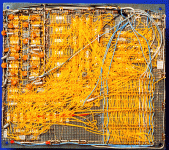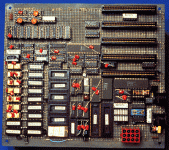Trash80toHP_Mini
NIGHT STALKER
As a group, we've collected a lot of information in the last iteration of this impossible dream:
IIsi PowerCache TwinSlot Adapter - Cloning Project
Now it's time to finally move from the theoretical to the practical . . . in wire wrap. For those of you who weren't born in the dark ages, wire wrapping was used to prototype the Apple1 through the Macintosh as well as the IBM PC. It was probably used to prototype everything else back to the dawn of the Dual Inline Package IC age of electronics as well.
www.nutsvolts.com - wire_wrap_is_alive_and_well
SJ wrapped boards for the Woz. Burrell Smith wrapped the first Macintosh Prototype as part of the Mac Development Team. Don't have any pics of those, so here's what the first IBM PCs looked like:


Sweet, found pics of Mac prototypes in folklore's PC Board Esthetics and Macintosh Prototypes articles:


This is what ProtoCache1 looks like during test fitting of the first 120 pin RA Male EuroDIN connector for the '030 PDS I spliced together from parts of two 96 pin "NuBus" connectors:
/monthly_05_2017/post-902-0-76475600-1495680303.jpg">View attachment 12863
It's not much, but it's a start. TimHD got in touch with me to see if pics of this passive Mobius adapter would be useful. Absolutely! Based upon that design I started plans to build ProtoCache1 in a gated configuration to act as passive IIci slot adapter or in active adapter mode with the flip of a DIP switch when I have new PALs to test in the sockets. Hopefully the one I have at hand will work, we'll see.

Samurai-j hooked me up with these pics of his Sonnet IIsi Adapter today. It's another passive card and I think I should be able to figure out the few connections that aren't plain as day on the three layers of this almost transparent card.


We'll see what happens, I'm already working in Illustrator to reverse engineer the other card TimHD has obtained. It's a single DIP PAL model, probably a fraternal twin of the PAL on the TwinSpark adapter. Omidomo will be helping out by buzzing connections on his TwinSpark,m so between these four examples and a pair of adapters that I have here, I think we're in pretty good shape. Time will tell.
I'm hoping that the prototype in passive mode will function correctly in my SE/30 with its Video ROM removed, disabling Video and hopefully removing memory conflicts with my 50MHz PowerCache. A Radius Color Pivot II IIsi will be installed in the PDS passthru. We'll see. [ ] ]'>
] ]'>
IIsi PowerCache TwinSlot Adapter - Cloning Project
Now it's time to finally move from the theoretical to the practical . . . in wire wrap. For those of you who weren't born in the dark ages, wire wrapping was used to prototype the Apple1 through the Macintosh as well as the IBM PC. It was probably used to prototype everything else back to the dawn of the Dual Inline Package IC age of electronics as well.
www.nutsvolts.com - wire_wrap_is_alive_and_well
SJ wrapped boards for the Woz. Burrell Smith wrapped the first Macintosh Prototype as part of the Mac Development Team. Don't have any pics of those, so here's what the first IBM PCs looked like:


Sweet, found pics of Mac prototypes in folklore's PC Board Esthetics and Macintosh Prototypes articles:


This is what ProtoCache1 looks like during test fitting of the first 120 pin RA Male EuroDIN connector for the '030 PDS I spliced together from parts of two 96 pin "NuBus" connectors:
/monthly_05_2017/post-902-0-76475600-1495680303.jpg">View attachment 12863
It's not much, but it's a start. TimHD got in touch with me to see if pics of this passive Mobius adapter would be useful. Absolutely! Based upon that design I started plans to build ProtoCache1 in a gated configuration to act as passive IIci slot adapter or in active adapter mode with the flip of a DIP switch when I have new PALs to test in the sockets. Hopefully the one I have at hand will work, we'll see.

Samurai-j hooked me up with these pics of his Sonnet IIsi Adapter today. It's another passive card and I think I should be able to figure out the few connections that aren't plain as day on the three layers of this almost transparent card.


We'll see what happens, I'm already working in Illustrator to reverse engineer the other card TimHD has obtained. It's a single DIP PAL model, probably a fraternal twin of the PAL on the TwinSpark adapter. Omidomo will be helping out by buzzing connections on his TwinSpark,m so between these four examples and a pair of adapters that I have here, I think we're in pretty good shape. Time will tell.
I'm hoping that the prototype in passive mode will function correctly in my SE/30 with its Video ROM removed, disabling Video and hopefully removing memory conflicts with my 50MHz PowerCache. A Radius Color Pivot II IIsi will be installed in the PDS passthru. We'll see. [


